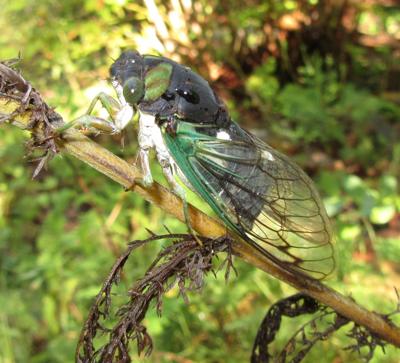©Marlene A. Condon
July 6, 2019

The other-worldly look of the common annual cicada often causes people to overlook the beauty of its unusual coloring. Courtesy of Marlene Condon
The common cicada in Virginia has a stout, black-and-green body, with clear wings. It’s a big insect, from one-to-two inches in length, with prominent eyes on a wide, blunt head sporting short, bristly antennae.
Males sing to attract mates, but they do not have vocal cords. They create the high-pitched whine that we hear on summer days by vibrating a pair of membranes near the base of the body. The membranes are attached to powerful muscles, which the cicada employs to very rapidly jerk the membranes, causing them to snap in and out.
A male cicada’s job is to provide sperm to as many female cicadas as possible before he dies. After he transfers his sperm to a female, she will use a sharp, spear-like egg-laying tube known as an ovipositor to make slits in numerous twigs. She pushes eggs through the tube into each slit as she makes it, laying perhaps 500 eggs by the time she dies.
The slits are obvious, if you want to look for them on the ends of the live branches of small trees. They are surrounded by fibers along the edges and are not very long. The twigs eventually die and turn brown because the nutrient flow has been severed.
You don’t need to worry about long-term harm to trees. They do not mind a bit of pruning. You can break or knock off the dead twigs, if you don’t like the way they look. However, patience will save you time and energy. The wind will eventually remove the dead twigs, if birds haven’t already done so.
In nature, the actions of one kind of organism are helpful to other kinds of critters. Consider any tree with dead twigs as a “home improvement store” for the numerous kinds of songbirds that need such twigs to build their nests in trees or shrubs. Instead of disliking the cicadas, think instead of how you are assisting birds to reproduce, and you can feel good about those dead twigs.
After the cicada eggs hatch, the immature cicadas — known as nymphs — soon drop off the twigs and search for a crack in the earth. When they find one, they start digging down and disappear to feed upon sap from the roots of trees. Adults also feed upon tree sap above ground.
Nymphs won’t see the light of day again until they emerge as adults in two to five years, despite being called “annual” insects. The reason some cicadas emerge every year is because there are different broods, which don’t all reach maturity at the same time.
Enjoy the summer chorus.
